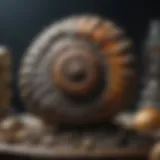Real Moldavite vs Fake Moldavite: A Comprehensive Analysis
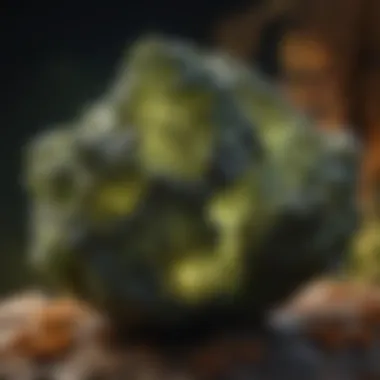

Intro
Moldavite intrigues many with its unique beauty and storied past. This rare stone, a type of tektite, originated from a meteorite impact. Its distinct green hue coupled with a history that dates back millions of years makes it a coveted collector's item. Determining authenticity is critical for those interested in moldavite, as numerous imitations saturate the market. This article serves as a comprehensive guide to distinguish real moldavite from counterfeit varieties.
Geological Origins
Real moldavite formed about 15 million years ago when a meteor struck what is now the Czech Republic. The intense heat and pressure caused by this impact transformed silica-rich earth into glass, leading to the creation of moldavite. Recognizing its geological significance is essential in understanding its true value and appeal.
Key Characteristics of Real Moldavite
Real moldavite is known for its unique characteristics. The following features help identify genuine specimens:
- Color: Authentic moldavite typically exhibits an olive green color, but shades can vary.
- Texture: Natural moldavite has a pitted surface with noticeable inclusions.
- Weight: Genuine moldavite is heavier than most glass imitations.
Being aware of these details can help collectors make informed decisions.
Techniques for Verification
Verification methods are critical in distinguishing real from fake moldavite. Here are several approaches:
- UV Light Test: Real moldavite fluoresces under ultraviolet light, while most fakes do not.
- Identification of Bubbles: Imitations often have air bubbles, whereas genuine specimens do not.
- Professional Appraisal: Consulting an expert can provide additional assurance on authenticity.
These methods can greatly reduce the risk of acquiring fakes.
Collecting Tips and Techniques
For those keen on moldavite collecting, several tips can enhance the experience:
- Research: Knowledge of reputable dealers is crucial.
- Networking: Engaging with communities, such as those on Reddit, can provide insights and information.
- Ethical Sourcing: Prioritize purchasing from ethical sources to support sustainable practices.
Employing these practices can foster responsible collecting.
Preservation and Display
Maintaining moldavite requires care. Here are some preservation techniques:
- Minimize Exposure: Store moldavite away from direct sunlight to prevent fading.
- Proper Storage: Use soft cloth bags or padded boxes for storage.
- Creative Display: Consider shadow boxes or glass cases to showcase pieces while keeping them safe.
Taking such measures ensures these delicate specimens are preserved for future enjoyment.
Impact of Fakes on the Collector Community
The rise of fake moldavite affects the collector community significantly. Fake pieces can undermine the market and mislead new collectors. Understanding the implications of collecting genuine pieces fosters a community rooted in authenticity.
Collectors should remain vigilant. Engaging in continuous learning about moldavite can fortify the appreciation for authentic specimens.
Finale
Understanding how to distinguish real moldavite from fakes enhances the collecting experience. Awareness of geological origins, key characteristics, and verification techniques provides a solid foundation for any enthusiast. As the market continues to evolve, informed collectors can contribute to an ethical and thriving community.
Understanding Moldavite
Moldavite is a unique and fascinating substance that piques the interest of many collectors and enthusiasts. To appreciate its true value, one must delve into its geological origins and distinct characteristics. Understanding Moldavite is crucial not just for identification purposes, but also for recognizing its significance in the world of gemstones. Many collectors seek out this stone not just for its looks, but for the stories and science behind it.
Real moldavite holds a unique charm that fakes cannot replicate. Its formation process, occurring from meteorite impacts, gives it a narrative that attracts many. When one learns about these aspects, it elevates the collecting experience.
Geological Origins of Moldavite
Moldavite is a natural glass created by the impact of a meteorite nearly 15 million years ago in what is now the Czech Republic. The heat produced during this impact caused terrestrial silica to melt and blow outward, forming distinctive glass pieces. Its origins make it a rare find, available only in this specific region. This geological background is not just a talking point; it underscores the authenticity of the stone, comparing it against inferior imitations. Knowing moldavite's origin can help collectors ensure they are investing in a genuine piece.
Describing Moldavite's Characteristics
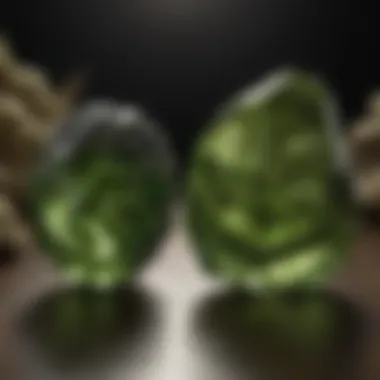

Moldavite is not only defined by where it comes from, but also by its prominent physical features. The following aspects are essential for understanding moldavite and identifying its real specimens:
Color Variations
Color is one of the most notable characteristics of moldavite. It typically ranges from pale green to deep olive shades. This range results from different iron concentrations and environmental factors during its formation. Some collectors prefer the darker hues because they often appear more dramatic and appealing. However, lighter pieces can have their own charm, appearing more mystical. Color variation is a vital identifier against counterfeit pieces, as many fakes attempt to mimic the deep greens of authentic moldavite, but often fail to achieve the same depth and richness.
Clarity and Transparency
Clarity is crucial in assessing the quality of moldavite. Authentic moldavite tends to be transparent or translucent, meaning light can pass through it to a certain degree. This characteristic contributes to its aesthetic appeal. Pieces with minimal inclusions are often the most sought after. Collectors need to be cautious, however, as many fakes may claim to be clear but are instead manufactured glass, lacking the unique qualities found in real moldavite. Thus, assessing clarity is another important step in ensuring authenticity.
Surface Textures
The surface of authentic moldavite displays unique textures. Often described as scuffed or patterned, these textures indicate how the stone was affected during its formation. No two pieces are exactly alike, which adds to the stone's appeal. In contrast, fake moldavite tends to have a polished surface, lacking the depth and character found in genuine specimens. Collectors must pay attention to these textures when determining whether a piece is authentic or not.
Each of these characteristics contributes to the comprehensive understanding of moldavite. By learning about its geological beginnings and physical traits, collectors can make informed decisions. Understanding moldavite effectively equips collectors with the right knowledge to identify quality from counterfeit products.
The Importance of Authenticity
When it comes to moldavite, authenticity is paramount. The significance of distinguishing real moldavite from its fake counterparts cannot be overstated. Authentic moldavite holds intrinsic value due to its unique formation and geological history, which cannot be replicated by artificial means. Unlike manufactured imitations, genuine moldavite is a tektite formed from cosmic events. The beauty and rarity of real moldavite attract collectors, but this also makes the market susceptible to fraud. Understanding why authenticity matters is crucial for collectors who want to invest not only in a specimen but also in its geological legacy.
Value of Real Moldavite
Real moldavite is highly sought after for various reasons. First, its value is largely determined by its geological origin, which is exclusively found in the Czech Republic. This limited supply contributes significantly to its market price. Moreover, genuine moldavite demonstrates distinct characteristics, such as its color variations and unique surface textures, which are often absent in fake versions. Depending on its quality, a piece of real moldavite can command high prices, often exceeding hundreds or even thousands of dollars.
Furthermore, owning authentic moldavite is not just an investment. It provides collectors with a tangible connection to the cosmos and the ancient events that formed the Earth itself. The historical significance adds another layer of value to these specimens, making them treasures for enthusiasts and collectors alike.
Consequences of Purchasing Fakes
Purchasing fake moldavite can have various repercussions beyond simply wasting money. Some of the most significant consequences include:
- Financial Loss: Many counterfeiters sell fake moldavite at inflated prices, leading buyers to invest in worthless items.
- Misleading Authenticity: Fakes undermine the integrity of the collecting community. When counterfeit pieces enter the market, it dilutes the value of genuine specimens and creates confusion among collectors.
- Emotional Disappointment: For many collectors, moldavite is more than a rock; it is a passion. Being misled into buying a fake can cause profound disappointment and frustration.
- Potential Legal Issues: In some cases, buying and selling counterfeits, especially if one is unaware, can lead to legal complications.
"The authenticity of moldavite is not just about the stone itself; it reflects the ethics of the collecting community."
To avoid these consequences, collectors should educate themselves thoroughly about how to identify genuine moldavite. Being aware of the differences between authentic and fake pieces allows collectors to make informed decisions and protect their investments.
Identifying Real Moldavite
Identifying real moldavite is a foundational element in distinguishing authentic pieces from imitations. Moldavite, a unique gemstone with extraterrestrial origins, is sought after for its beauty and supposed energetic properties. The value of a genuine specimen can be significant, making it crucial for collectors and enthusiasts to understand how to verify the authenticity of their pieces. This section discusses various techniques, both physical and scientific, that aid in identifying real moldavite.
Physical Inspection Techniques
Light Test
The Light Test is an essential method for assessing the authenticity of moldavite. This technique utilises the unique optical properties inherent in genuine moldavite. When exposed to light, real moldavite displays a distinctive glow and may refract light in unusual ways that are less common in fake pieces, like manufactured glass.
The key characteristic of the Light Test is its accessibility. Collectors can perform this test without specialized equipment. However, it is important to note that this method may require practice to interpret the results effectively. One advantage of the Light Test is its immediate feedback—it allows collectors to quickly gauge whether a piece is likely genuine.
Weight and Density
Weight and density are also vital factors in identifying real moldavite. Authentic moldavite is lighter than most imitation materials such as glass. By weighing the specimen and comparing it to its size, collectors can get a sense of its authenticity.
One key characteristic of this testing method is that genuine moldavite tends to have a specific density range that imitators struggle to replicate. This makes it a beneficial choice for collectors aiming to authenticate their pieces. However, it is crucial to use a precise scale, as imprecise measurements can lead to errors in assessment.
Texture Assessment
Texture Assessment involves examining the surface quality of the moldavite. Real moldavite often exhibits a unique tactile feel that differentiates it from glass or other imitative materials. By feeling the texture, collectors can identify slight irregularities that indicate authenticity.
The key characteristic of texture is its variability; authentic moldavite shows variations in texture that reflect its natural formation process. It can be a useful choice for collectors familiar with the feel of genuine specimens. However, this method requires experience and might not be easily discernible for first-time buyers.
In-Depth Laboratory Tests
Spectroscopy
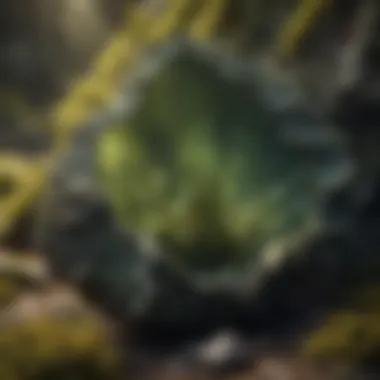

Spectroscopy is a powerful technique that reveals the molecular structure of a sample. This method can identify the specific wavelengths of light absorbed by the material, which is unique to real moldavite. The results from spectroscopy can definitively classify a piece as genuine or a fake, making it a preferred choice in formal assessments.
The key characteristic of this method is its scientific basis, which provides reliable results. While not always accessible for casual collectors, spectroscopy is invaluable in contexts where authenticity is paramount. However, the main downside is that it requires specialized equipment and expertise, limiting its practicality for everyday use.
Refractive Index Measurement
The Refractive Index Measurement method evaluates how much light bends when it passes through a material. Authentic moldavite has a specific refractive index that differs from imitative materials. This test can quickly confirm the authenticity of a specimen.
The significant aspect of this measurement is its precision. Unlike physical tests, this method provides exact data that leaves less room for interpretation. However, like spectroscopy, it necessitates proper equipment, which could hinder its use for casual assessments.
Chemical Composition Analysis
Chemical Composition Analysis involves examining the elemental makeup of a specimen. Real moldavite has a unique chemical signature, primarily consisting of silicon, oxygen, and trace elements, which can be precisely measured in a lab. This method of verification can conclusively distinguish genuine moldavite from fakes.
The key characteristic of chemical analysis is its accuracy. Results can provide invaluable information regarding the material's authenticity. However, accessibility to this analysis can be limited, as it typically requires sending specimens to a specialized facility for testing.
Key Takeaway: Being able to identify real moldavite is crucial for collectors. Using both physical inspection and laboratory tests can help protect against investing in fakes while ensuring that your collection remains authentic and valuable.
Common Types of Fake Moldavite
Understanding the differences between real and fake moldavite is critical for collectors who wish to make informed purchases. The market for moldavite has grown, but so has the presence of counterfeit products. Recognizing the common types of fake moldavite can help collectors avoid regrettable purchases and ensure they are acquiring genuine pieces. This understanding not only protects their investment but also enhances the overall collecting experience.
Manufactured Glass Imitations
Manufactured glass imitations are perhaps the most prevalent type of fake moldavite. These specimens are created in laboratories and can sometimes be indistinguishable from genuine moldavite to the untrained eye. The primary allure of these imitations lies in their appearance which may mimic the color and some characteristics of real moldavite. However, they lack the unique geological history that authentic moldavite possesses.
Collectors often find glass imitations appealing due to their lower price. It is crucial to be aware that despite their visual resemblance, these pieces do not carry the same metaphysical properties or value as authentic moldavite.
Signs to look for include:
- Uniformity in Structure: Real moldavite often has irregular shapes and textures while glass imitations are usually too uniform.
- Weight: Glass tends to be heavier than moldavite. This difference can often be felt when holding the piece.
- Surface Characteristics: Authentic moldavite has a distinctive texture, including etchings and pits that indicate natural formation. Glass imitations typically appear smoother and lack these details.
"Fakes can be very deceptive. Always trust your instincts and employ proper testing methods."
Heat-Treated Specimens
Heat-treated specimens also pose a significant challenge for collectors. These pieces are typically created from lower-quality natural glass that undergoes thermal treatment to enhance their color and appearance. The heat treatment process can make these specimens look strikingly similar to real moldavite, thus complicating the verification process.
While some heat-treated specimens retain certain natural characteristics, the alteration process can lead to noticeable differences. Key indicators to identify heat-treated moldavite include:
- Abnormal Shine: Authentic moldavite usually has a more muted luster compared to the shiny finish that heat treatment can produce.
- Color Variability: Heat treatments often result in synthetic hues that might not occur in natural specimens.
- Inconsistent Density: Changes in density from heat treatment may affect weight, further helping to distinguish these pieces from authentic moldavite.
Understanding these categories of fake moldavite is essential for any serious collector. Knowledge about their characteristics not only helps in avoiding financial loss but also enriches appreciation for the genuine articles. By being vigilant and informed, collectors can navigate the market more confidently.
Market Trends and Pricing
Understanding the market trends and pricing of moldavite is crucial for collectors. This knowledge helps collectors make informed decisions when purchasing this unique gemstone. Recognizing how the market fluctuates allows collectors to navigate potential pitfalls, such as buying fake specimens or overpaying for genuine pieces. The following sections will delve deeper into recent trends and the various factors that influence pricing.
Recent Trends in Moldavite Sales
The market for moldavite has seen a noticeable shift in recent years. A rise in demand for rare and unique stones has propelled moldavite into the spotlight among collectors. Online sales platforms have made it easier for buyers to access a wide range of specimens. Social media also plays a role, as collectors share their finds and experiences, creating a community that values moldavite. This increased visibility can drive up prices, making it important for buyers to stay informed about current market conditions.
Another trend includes the growing interest in metaphysical properties associated with moldavite. Many collectors believe it holds spiritual significance. This aspect adds an emotional value beyond the physical, further influencing market prices. The blend of rarity, aesthetic appeal, and supposed metaphysical benefits has made moldavite a sought-after item in both collector circles and casual buyers.
Price Determinants for Authentic Specimens
Understanding the determinants of price can help collectors assess the true worth of a moldavite specimen. Various factors contribute to pricing, among which rarity, market demand, and the condition of the piece are paramount.
Rarity Factors
Rarity is a significant aspect in determining the value of moldavite. The specific context of moldavite's geologic formation makes it relatively rare. There are limited locations from which authentic moldavite can be sourced, primarily the Czech Republic. The unique provenance enhances its appeal. Collectors often seek items that are not only genuine but also rare in specific colors or formations. The scarcity of particular specimens directly impacts their market price, making rarer pieces more valuable. In this sense, rarity is a strong investment choice for collectors.
Market Demand
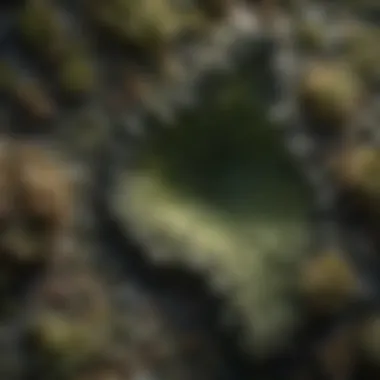

Market demand heavily influences pricing trends. As interest in moldavite grows, the demand naturally increases. This can create competitive pricing situations, especially at auctions or high-demand sales periods. The perception of moldavite as a trendy collectible can lead to inflated prices. Thus, collectors must balance their buying strategy with an understanding of current market dynamics to avoid paying overvalued prices. Knowing when to buy or hold off can greatly affect overall investment outcomes.
Condition of the Piece
The condition of a moldavite specimen is another critical factor for pricing. Higher-quality pieces with minimal inclusions, chips, or scratches often command better prices. A well-maintained specimen showcases the stone's natural beauty, making it more appealing to potential buyers. Conversely, pieces in poor condition can see significant declines in value. Collectors take great care in assessing and documenting the condition of each piece before making a purchase. This consideration ensures that they acquire specimens that hold both aesthetic and financial value.
"The importance of understanding market trends and price determinants cannot be overstated. Knowledge provides leverage when investing in moldavite."
By keeping these factors in mind, collectors can navigate the complex landscape of moldavite sales with greater confidence and insight.
Ethical Considerations in Collecting Moldavite
The thoughtful collection of moldavite extends beyond mere aesthetic appreciation or investment potential. Ethical considerations play a vital role in how collectors engage with this unique gemstone. This section explores key elements in responsible collecting, providing insights that can benefit both the collector and the planet.
Impact on Geological Conservation
Moldavite is a rare natural glass formed from meteorite impacts, making its geological origins significant. When collectors acquire moldavite, their choices can influence geological conservation efforts. Excessive mining and poaching can lead to depletion of resources and damage to natural habitats. It is crucial for collectors to understand that their purchases can have tangible effects on the environment.
Educating oneself about the sourcing of moldavite is essential. Collectors should prioritize purchasing from reputable dealers who emphasize sustainable practices. Supporting operations that engage in responsible harvesting can help preserve geological sites. Additionally, awareness of local regulations also matters. Many areas have laws protecting geological resources that collectors must abide by.
Supporting Sustainable Sources
The act of collecting moldavite carries the weight of responsibility. By consciously supporting sustainable sources, collectors can contribute positively to the moldavite market. Sustainable sourcing refers to obtaining materials through practices that do not harm the environment or deplete natural resources.
When choosing where to buy moldavite, collectors can look for the following aspects:
- Certifications: Seek out businesses that provide proof of sustainable practices. Many sellers may be part of organizations that endorse ethical sourcing.
- Transparency: Inquire about the origin of the moldavite. A trustworthy seller will openly share information about sourcing practices and mining locations.
- Local Impact: Purchase from local dealers who support their communities. The benefits can extend beyond the collector’s immediate interests, fostering local economies.
Investing in sustainably-sourced moldavite aligns with ethical collecting practices. It ensures that future generations may also appreciate this remarkable gemstone.
"Moldavite carries with it not only a sense of beauty but also a responsibility towards our planet. Collecting it ethically can foster sustainable practices and support conservation efforts."
Community Perspectives
Community perspectives play an essential role in understanding the authenticity of moldavite. The collector community provides a wealth of experience and knowledge that can aid both novice and seasoned collectors in distinguishing genuine pieces from fakes. Views expressed within these communities also shed light on challenges faced by collectors. As the market for moldavite grows, understanding these perspectives can foster more informed purchasing decisions, ultimately enhancing the integrity of the collecting experience.
Collector Experiences and Testimonials
The voices of collectors can reveal firsthand accounts of both success and setbacks when it comes to acquiring moldavite. Many collectors share their journey, illustrating how they had to navigate the murky waters of fake products.
- Authentic Encounters: Numerous enthusiasts recount their excitement when they identified a genuine specimen. They often describe the thrill of holding a piece of meteorite glass that formed billions of years ago. These stories can inspire others to educate themselves further on the subject.
- Lessons from Mistakes: Some collectors, however, recount their experiences purchasing fakes. Their testimonials usually highlight the mistake of not conducting proper research before buying. These narratives serve as cautionary tales, stressing the importance of verifying the authenticity of a piece before making a purchase.
Using online platforms like Reddit and Facebook, collectors have created communities where they can share these experiences. The feedback loop established in these interactive spaces helps others learn from each other’s experiences, often resulting in a more educated community. Collectors often post photos of their moldavite pieces, requesting opinions about their authenticity, which fosters collective knowledge.
Expert Opinions on Fakes
Experts add another layer of credibility when discussing moldavite authenticity. Their insights are invaluable because they bring a scientific approach to the field. Experts often weigh in on the characteristics that distinguish real moldavite from imitations.
- Material Science: Knowledgeable gemologists and mineralogists frequently emphasize the significance of laboratory testing. They may utilize advanced techniques such as spectroscopy or refractive index measurements to analyze moldavite. Their findings often reveal the unique properties of natural moldavite that are absent in fakes, affirming the need for professional evaluation.
- Market Trends: Experts in geology also keep an eye on market trends, providing insights into how the growing popularity of moldavite affects the proliferation of counterfeit products. This information serves as a useful gauge for collectors, helping them understand how much they should pay and why certain pieces might be suspiciously cheap.
Overall, community perspectives enrich the understanding of moldavite authenticity. The shared experiences of collectors and the expert opinions on fakes provide a balanced view that can empower buyers with the necessary knowledge for informed decisions.
The End
In the realm of moldavite collecting, understanding authenticity is crucial. The distinctions between real and fake moldavite impact not only the value of pieces but also the integrity of collectors and the market at large. A clear grasp of the intricate details surrounding moldavite authenticity ensures collectors make informed choices. It fosters responsible collecting practices, preserving both the geological heritage and the collector community's reputation.
Final Thoughts on Authenticity
Authenticity serves as a cornerstone in the appreciation of moldavite. Authentic moldavite is distinguished by its unique features—its distinct color variations, specific surface textures, and transparency levels. Knowledge of these characteristics is essential for any serious collector. When acquiring moldavite, always prioritize authenticity over aesthetics. A genuine piece is not merely an ornament but a connection to the Earth's deep history.
In addition to understanding the physical aspects, being aware of resource authenticity matters greatly. With many imitations flooding the market, often with clever alterations, staying informed protects both investment and passion. Collectors should always request certificates of authenticity when purchasing moldavite, adding an extra layer of protection against forgeries. The pursuit of genuine pieces elevates the experience of collecting moldavite.
Future of Moldavite Collecting
Looking ahead, the future of moldavite collecting is both promising yet challenging. The demand for genuine moldavite appears to grow, correlating with increased interest in crystals and healing stones. As awareness increases, so does the risk of encountering sophisticated fakes. It is essential for the collecting community to adapt by sharing knowledge, experiences, and lessons learned about authenticity.
Additionally, technological advancements may provide new tools for verification. From lab analyses to more effective testing methods, realizing these innovations can aid collectors in distinguishing genuine moldavite from imitations. Furthermore, ethical sourcing is becoming increasingly important. Future collectors must not only ensure authenticity but also support sustainable practices that safeguard both geological formations and the market.
In summary, the pathway forward in moldavite collecting hinges on a commitment to authenticity and ethics. By fostering a community of informed collectors, not only do we protect our own investments but also contribute to a culture of integrity and respect for the natural world.
